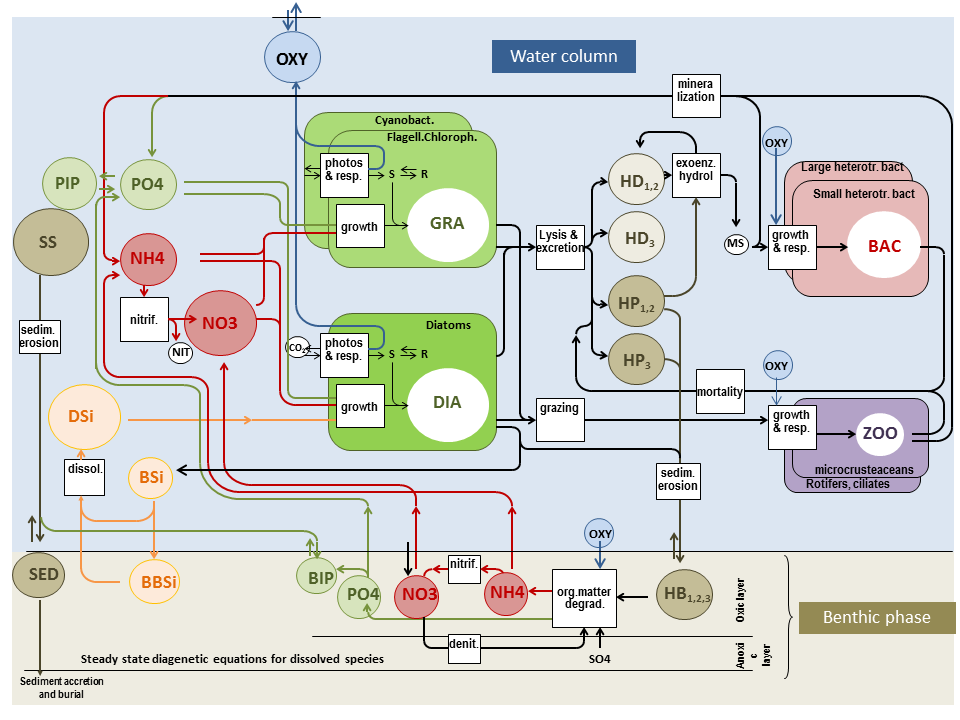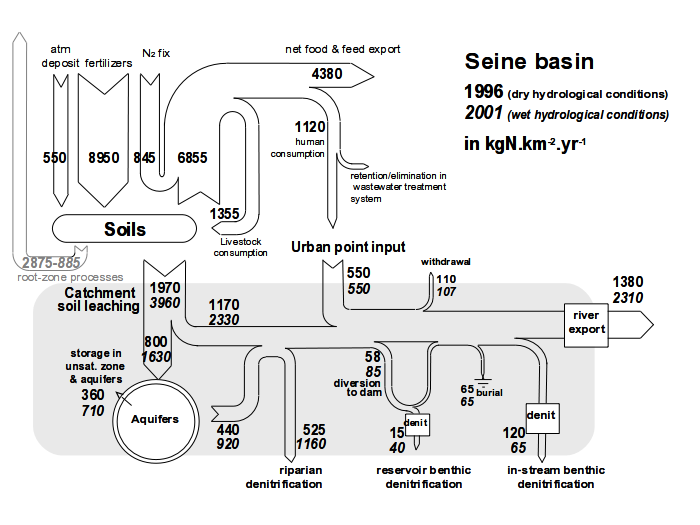Generic river basin model used in EMoSEM
The aim of the deterministic Riverstrahler model (Billen et al., 1994) is to represent the impact of human activities on the quality of river systems, by taking into account the physiology of algal developments and simulating the biogeochemical cycles of carbon, nitrogen, phosphorus and silica (fig. 1).

Fig. 1: Schematic representation of biogeochemical processes include in the Riverstrahler model
The Riverstrahler approach assumes that the singular functioning of aquatic ecosystems is directly related to the variety of constraints applied to the aquatic continuum. Thereby, an accurate description of these constraints is the key to understand the functioning of any hydrosystem, and the generic Riverstrahler has already been successfully applied to several river systems across the world (table 1).
| River basin | Publications |
|---|---|
|
Temperate systems:
|
|
|
Continental systems:
|
|
|
Sub-tropical systems:
|
|
|
Sub-artic systems:
|
|
The Riverstrahler model explicitly calculates most of the processes important in the transformation, elimination, and/or immobilization of nutrients during their transfer within the network (fig. 2), starting with small first-order streams until large tributaries exporting nutrient to coastal sea.

Fig 2: Budget of nitrogen transfers and transformation in the Seine river basin, as calculated by the Rivestrahler model for recent typical wet (2001) en dry (1996) hydrological conditions. Adapted from Billen et al. 2009
References
Billen, G., J. Garnier, and P. Hanset (1994), Modelling phytoplankton development in whole drainage networks: the RIVERSTRAHLER Model applied to the Seine river system, Hydrobiologia, 289, 119-137.
Garnier, J., G. Billen, and L. Palfner (1999), Understanding the oxygen budget and related ecological processes in the river Mosel: the RIVERSTRAHLER approach, Hydrobiologia, 410, 151-166, doi: 10.1023/A:1003894200796.
Garnier, J., G. Billen, E. Hannon, S. Fonbonne, Y. Videnina, and Soulie (2002), Modeling transfer and retention of nutrients in the drainage network of the Danube River, Estuar. Coast. Shelf Sciences, 54, 285-308, doi: 10.1006/ecss.2000.0648.
Le, T. P. Q., J. Garnier, B. Gilles, T. Sylvain, and C. Van Minh (2007), The changing flow regime and sediment load of the Red River, Viet Nam, Journal of Hydrology, 334(1-2), 199-214, doi: 10.1016/j.jhydrol.2006.10.020.
Luu T.N.M., J. Garnier , G. Billen, Le T.P.Q., J. Némery, D. Orange. And Le L.A.,(2011), N,P and Si budgets for the Red River Delta (Northern Vietnam). How the delta affects river nutrient delivery to the sea? ., Biogeochemistry.
Ruelland, D., G. Billen, D. Brunstein, and J. Garnier (2007), SENEQUE 3: a GIS interface to the RIVERSTRAHLER model of the biogeochemical functioning of river systems, Science of the Total Environment, 375, 257-273, doi: 10.1016/j.scitotenv.2006.12.014.
Passy, P., N. Gypens, G. Billen, J. Garnier, C. Lancelot,V. Thieu, V. Rousseau, J. Callens,(2012) A Model reconstruction of riverine nutrient fluxes and eutrophication in the Belgian Coastal Zone (Southern North Sea) since 1984. Journal of Marine Systems (in press)
Sferratore, A., G. Billen, J. Garnier, E. Smedberg, C. Humborg, and L. Rahm (2008), Modelling nutrient fluxes from sub-arctic basins: comparison of pristine vs. dammed rivers, Journal of Marine Systems, 73(3-4), 236-249, doi: 10.1016/j.jmarsys.2007.10.012.

